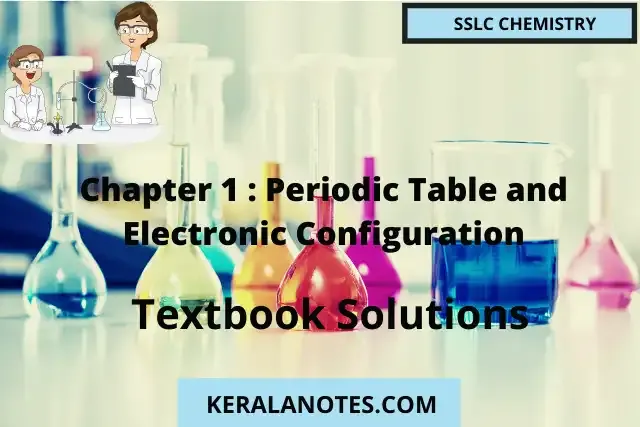The textbook solutions for SSLC's Science curriculum begins with a chapter on the periodic table and electronic configuration. Middle school level study is a challenging task, but it is manageable if you know how to approach it. To help students better comprehend chemistry and the world around them, this chapter on the periodic table and electronic configuration aims to clarify the fundamentals of what they will meet in their studies.
Recently, the first chapter of the Kerala SSLC exam syllabus was made public. The periodic table and electronic configuration are covered in this chapter. This article can assist you better understand the concept if you are preparing for the Kerala SSLC exam. All of the chapter's questions are answered here, along with thorough explanations.
| Board | SCERT, Kerala |
| Text Book | SCERT Based |
| Class | SSLC |
| Subject | Chemistry Solution |
| Chapter | Chapter 1 |
| Chapter Name | Periodic Table and Electronic Configuration |
| Category | Kerala SSLC |
Kerala Syllabus SSLC Class 10 Chemistry Textbook Solution Chapter 1 Periodic Table and Electronic Configuration
- Chapter 1: Periodic Table and Electronic Configuration
- Chapter 2: Gas Laws Mole Concept
- Chapter 3: Reactivity Series and Electrochemistry
- Chapter 4: Production of Metals
- Chapter 5: Compounds of Non-Metals
- Chapter 6: Nomenclature of Organic Compounds and Isomerism
- Chapter 7: Chemical Reactions of Organic Compounds
SSLC Chemistry Part I
SSLC Chemistry Part II
Chapter 1 Periodic Table and Electronic Configuration Textbook Solution
Let us Assess
Based on the hints given, find out the atomic number and write down the subshell electronic configuration of elements (The symbols used are not real).
i) A - period 3 group 17
ii) B - period 4 group 6
- Answer)
i) A atomic number = 17
1s2 2s2 2p6 3s2 3p5
i) A atomic number = 24
1s2 2s2 2p6 3s2 3p6 3d5 4s1
When the last electron of an atom was filled in the 3d subshell, the subshell electronic configuration was 3d8. Answer the questions related to this atom
- Complete subshell electronic configuration
- Atomic number
- Block
- Period number
- Group number
- Answer)
- 1s2 2s2 2p63s23p63d84s2
- Atomic number - 28
- Block - d Block
- Period number - 4
- Group number- 10
Pick out the wrong subshell electronic configuration from those given below.
a) 1s2 2s2 2p7
b) 1s2 2s2 2p2
c)1s2 2s2 2p5 3s1
d)1s2 2s2 2p6 3s2 3p6 3d2 4s1
e)1s2 2s2 2p6 3s2 3p6 3d2 4s2
- Answer)
a) 1s2 2s2 2p7
c)1s2 2s2 2p5 3s1
d)1s2 2s2 2p6 3s2 3p6 3d2 4s1
The element X in group 17 has 3 shells. If so,
a) write the subshell electronic configuration of the element'
b) Write the period number.
c) What will be the chemical formula of the compound formed if the element X reacts with Y of the third period which contains one electron in the p subshell?
- Answer)
a) 1s2 2s2 2p6 3s2 3p5
b) 3
c) YX3
The element Cu with atomic number 29 undergoes a chemical reaction to form an ion with oxidation number +2.
a) Write down the subshell electronic configuration of this ion?
b) can this element show variable valency? Why?
c) Write down the chemical formula of one compound formed when this element reacts with chlorine(17Cl).
- Answer)
a) Cu 1s2 2s2 2p6 3s2 3p6 3d10 4s1
Cu2+ 1s2 2s2 2p6 3s2 3p6 3d9
b) Yes. it loses both outermost 's' electrons and penultimate 'd' electrons in chemical reaction.
c) CuCl2 or CuCl
Certain subshells are given below.
2s,2d,3f,3d,5s,3p
a) Which are the subshells that are not possible?
b) Give reason.
- Answer)
a) Not possible 2d,3f
2nd shell does not contain a 'd' subshell
3rd shell does not contain an 'F' subshell
SSLC Chemistry Textbook Solution
- Chapter 1: Periodic Table and Electronic Configuration
- Chapter 2: Gas Laws Mole Concept
- Chapter 3: Reactivity Series and Electrochemistry
- Chapter 4: Production of Metals
- Chapter 5: Compounds of Non-Metals
- Chapter 6: Nomenclature of Organic Compounds and Isomerism
- Chapter 7: Chemical Reactions of Organic Compounds
SSLC Chemistry Part I
SSLC Chemistry Part II
SSLC Chemistry Related Links
| SSLC Chemistry Notes | Click Here |
| SSLC Chemistry Textbook Solutions | Click Here |
| SSLC Focus Area | Click Here |
| SSLC Previous Year Questions with Solution | Click Here |
| SSLC Latest Syllabus | Click Here |
Other Related Links
| SSLC Physics | Click Here |
| SSLC Chemistry | Click Here |
| SSLC Mathematics | Click Here |
| SSLC Biology | Click Here |
| SSLC Social Science | Click Here |
| SSLC English | Click Here |






